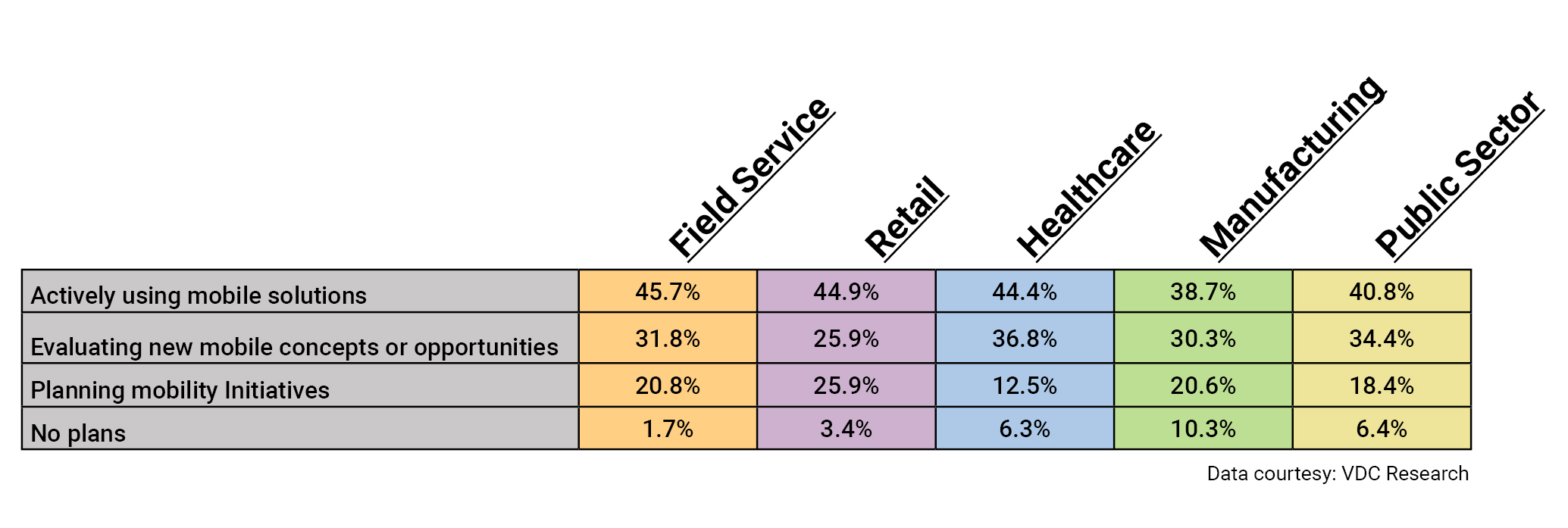Industry Trends in Enterprise Mobility
Today, industries that embrace the digital transformation realize that a mobile-first strategy is not a luxury, but a necessity.
How IT administrators take advantage of mobility varies from industry to industry. Mobility in retail is
quite different than mobility in heavily regulated environments such as healthcare or finance. But the end goal is the same: improve workflows and productivity as well increase customer engagement and enhance the user experience. Companies embarking
on their digital transformation journeys now are setting the pace for how technology is redefining workflows.
“Basically the future of enterprise mobility is to deliver workflows that can run anywhere on any device without compromising
the UX or security,” said Maribel Lopez, Owner of Lopez Research. “In an ideal world, we’d create apps that are better than their predecessors and applications that can leverage context such as location, motion and image capture.”
A report by the Enterprise Mobility Exchange: The Edge of Enterprise Mobility: Which Industries Lead the Way,
which incorporates data from VDC research, provides data on how enterprise mobility is being embraced in different industries. There are two categories of mobility. The first is in company facing and focused on optimizing systems and cost savings.
The second is outward facing and focused on improving customer engagement and experience.
Take a look and see how your industry compares in terms of mobility.

Field service leads the way, but that
is not unexpected. Field service is, by definition, having technicians working at the customer’s site or at the company’s remote sites, such as cable technicians, home nurses or mining engineers. Field service is literally working at the digital
edge and enterprise mobility is enhancing the way users work, collect data and communicate.
Retail. Retail has been a leader in digital transformation, including mobility, innovating new and dynamic ways to interact with customers from coupon
sites such as eBates or Retail Me Not to predictive artificial intelligence algorithms that make shopping recommendations. And consumers are embracing it and expecting it. For example, 90% of traffic on coupon sites is from mobile devices and 80% of mobile
device usage is through apps rather than web browsing (ComScore). Retail will continue to embrace mobility and introduce new ways to interact with customers.
Healthcare is aggressive in its digital transformation journey. More than any
other industry, mobility is changing the face of healthcare from clinical care to compliance with regulations. Mobility in healthcare is mission-critical and touches patients, physicians and administrators everywhere from treatment programs to IoMT (Internet
of Medical Things) devices. Fail-proof mobility is expected in healthcare and is integrated into how healthcare is administrated. For example, 80% of physicians use handheld devices and medical apps for patient care. It’s estimated that in 2018,
65% of interactions with healthcare facilities will occur on mobile devices.
Manufacturing. To improve processes and reduce costs, manufacturers have been embracing their digital transformation with the IoT, machine learning and artificial
intelligence. Mobility plays an increasingly important role in terms of safety, monitoring equipment and preventative maintenance. It can also provide a redundant, fail-safe backdoor to remote sites if the primary cable connections fail.
Public Sector. The most surprising figure is the public sector rate. Government agencies and public safety providers, transportation, utilities and other public services have typically been slow to adopt new technologies due to budgetary constraints,
security concerns and regulations. While lagging behind the private sector, the public sector is making headway in enabling mobile applications.
Moving mobility strategies forward
Digital transformation is being fueled by enterprise mobility.
It’s integrated into the daily lives of millions of workers and is fundamentally changing how we interact and our workflows.
“The number of organizations that are mobilizing applications is accelerating,” said Eric Klein,
Analyst with VDC, “specifically in industries where mobile solutions have been business-critical. We expect adoption in these industries to continue to gain steam, as organizations come to recognize that investments in new tools can help to save
time in their coding and prototyping processes as well as minimize costs while improving communication and collaboration across their organizations.”
With enterprise mobility comes change and disruption. But that’s a good thing
for IT administrators. It gives them the ability to drive innovation as they look for new ways to streamline processes. Change gives them the ability to become an influencer rather than an implementer .
Learn how to Make Mobility Happen in your Enterprise at BlackBox.com/Mobility.
http://web3.blackbox.com/Mobility
Artifical Intellegence (AI)
Black Box insights
business mobility
Digital Edge
Enterprise Mobility
IoT
mobile innovations
mobile technology
mobility solutions
mobility strategies
mobility trends
Technology Trends
Wireless Technologies
workplace mobility
